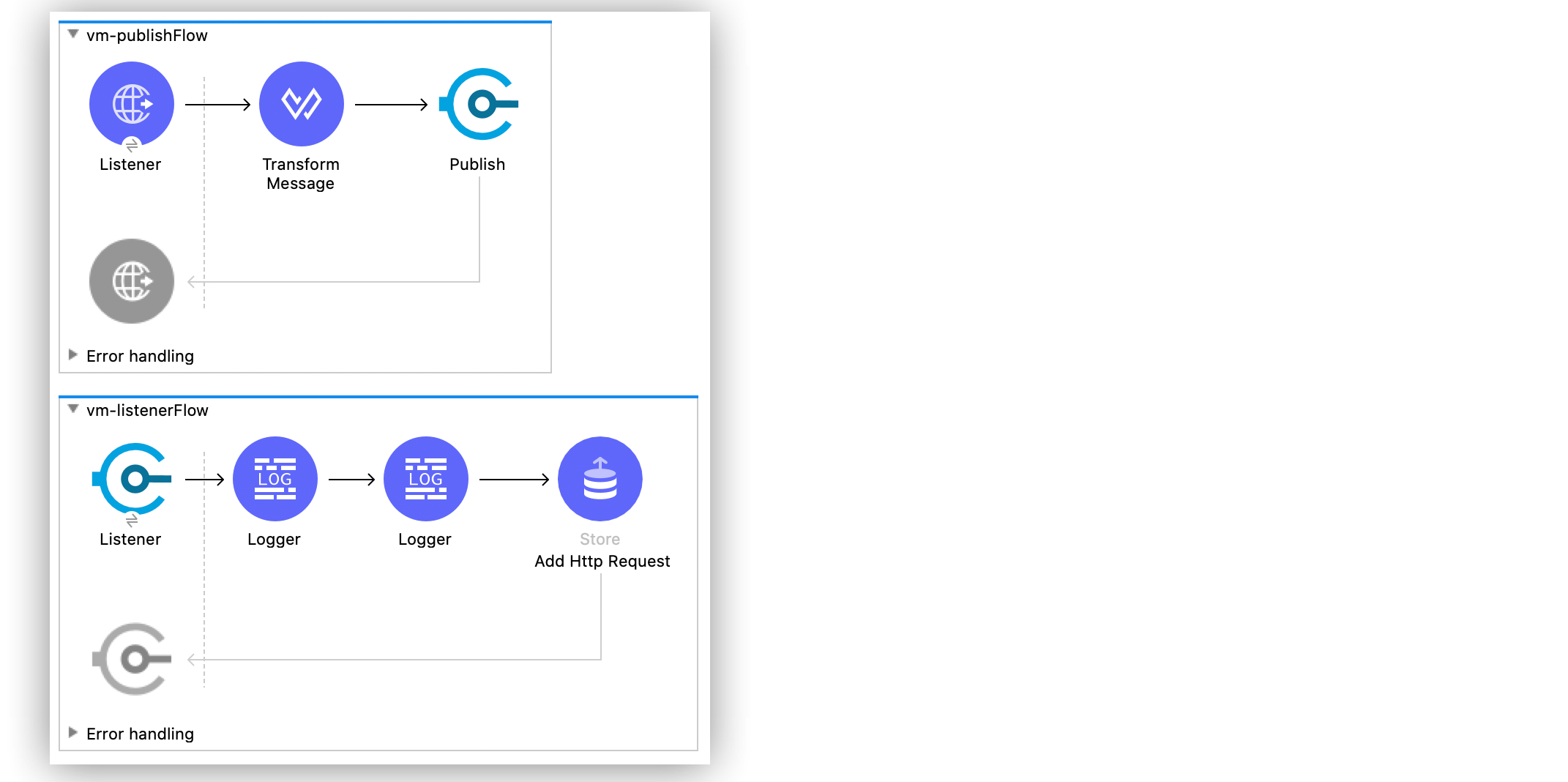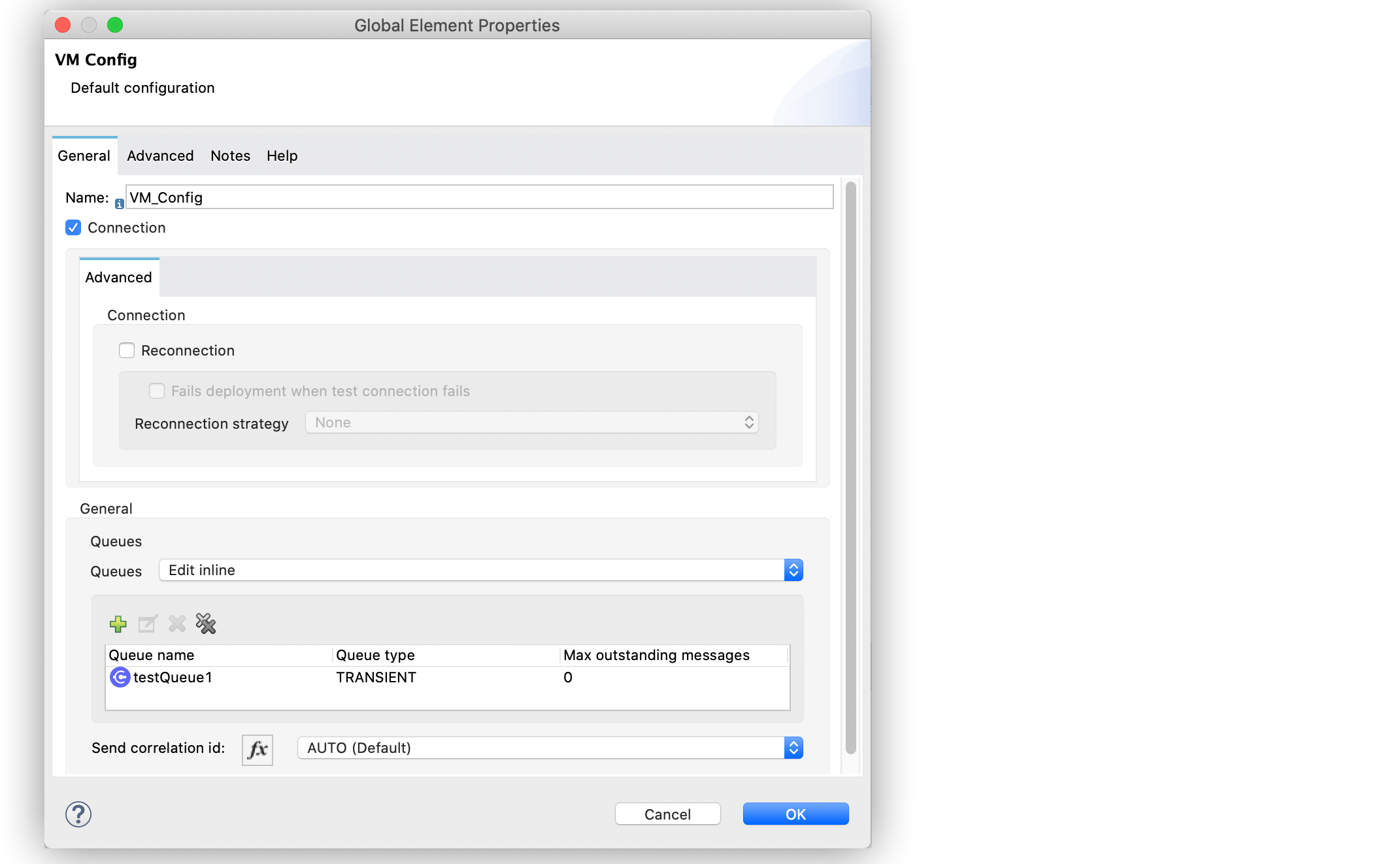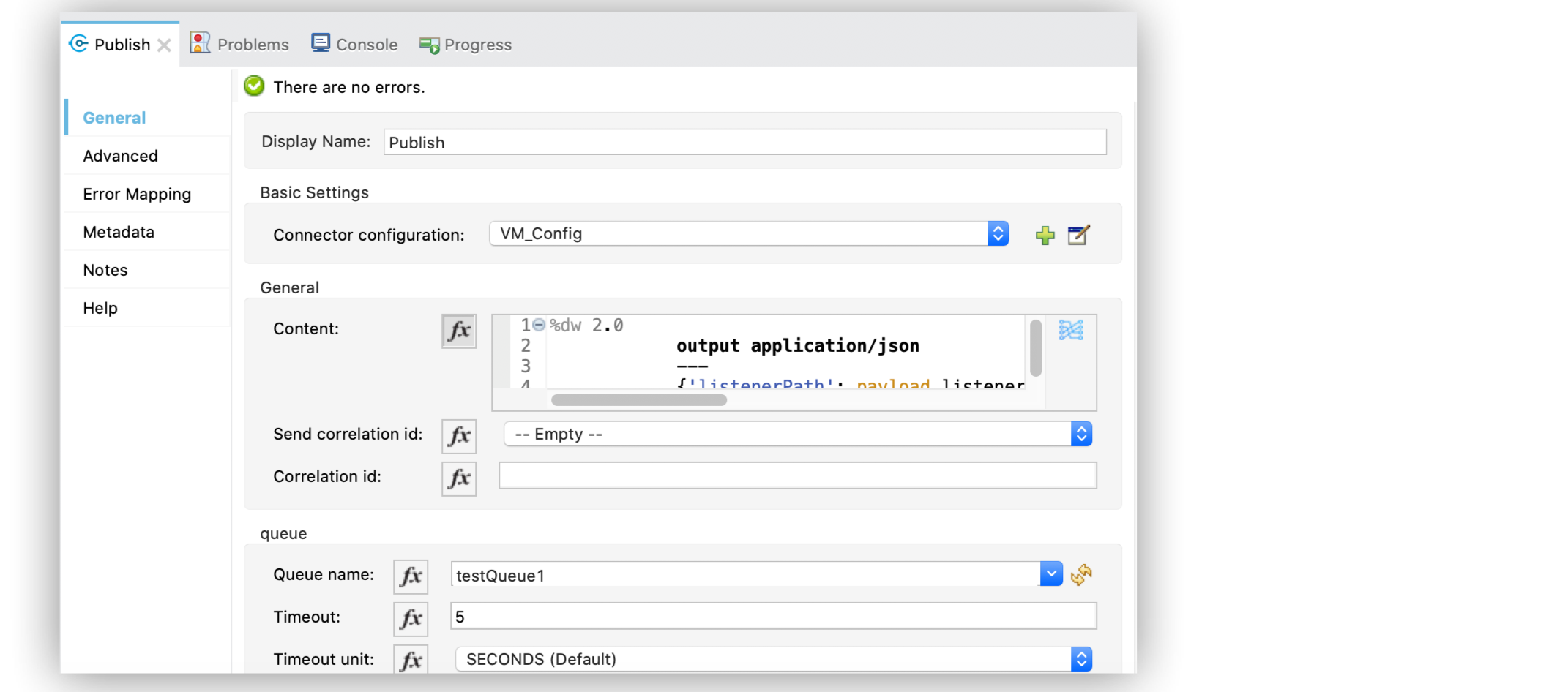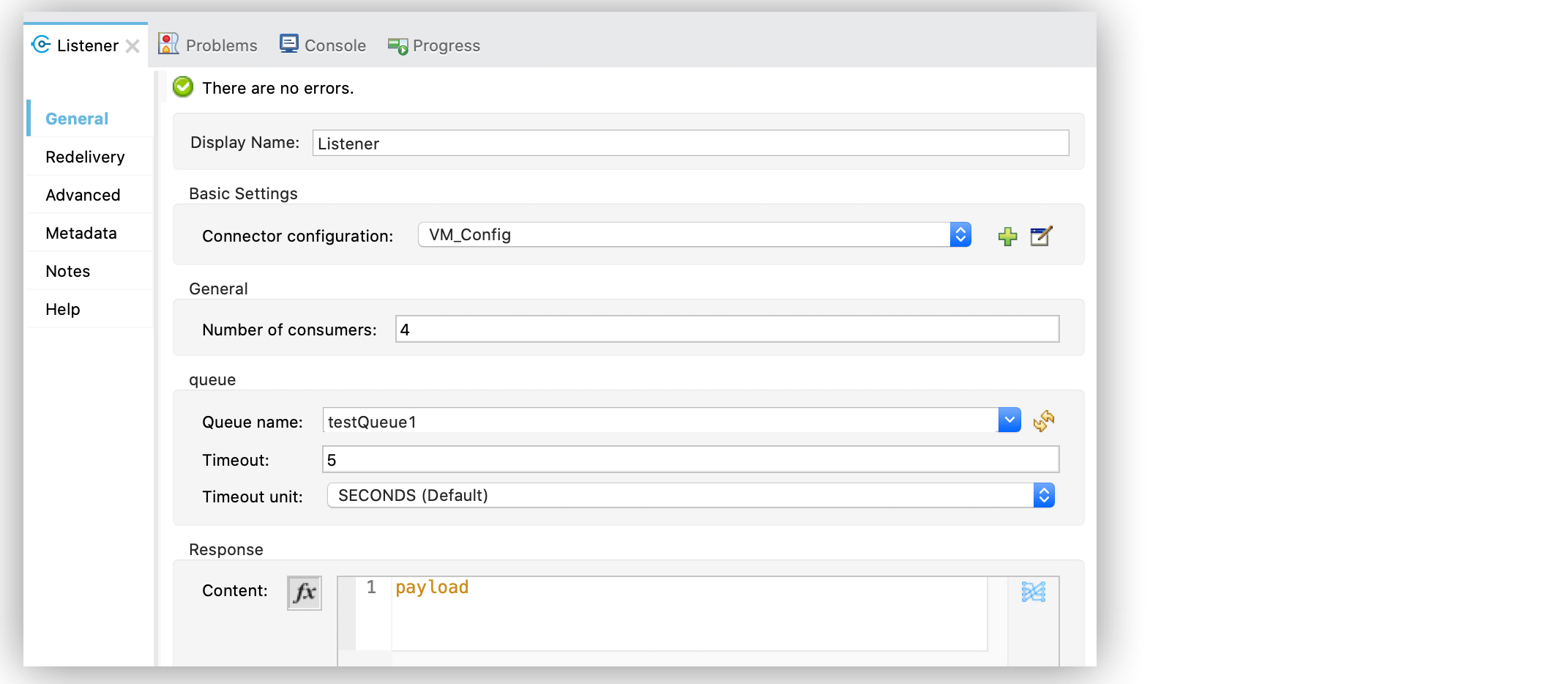
VM Connector Propagate Message Attributes Example
The following example illustrates how you can propagate message attributes through a VM queue via a message payload. The first flow takes incoming HTTP message attributes and additionally creates a custom attribute of its own, and then adds both of these attributes into a message payload so the VM Publish operation can publish the message to a VM queue. In the second flow, the VM Listener source receives the message payload from the previous flow and sets its own message attributes, and the message payload is finally stored in an object store.
The following screenshot shows the Anypoint Studio app flow for this example:

Create the VM Publishing Flow
The VM publishing flow first listens for incoming HTTP message attributes and then transforms the message attributes into a JSON structure message. Finally the VM Publish operation publishes the message in a VM queue.
To create the VM publishing flow:
-
Create a new Mule project in Studio.
-
In the Mule Palette view, select the HTTP Listener source and drag it into the canvas.
The source listens for incoming HTTP messages attributes. -
On the HTTP Listener configuration screen, set the Path field to
/message. -
Click the plus sign (+) next to the Connector configuration field to configure a global element that can be used by all instances of the HTTP Listener in the app.
-
In the Connection section, set Protocol to
HTTP (Default), Host toAll Interfaces [0.0.0.0] (default), and Port to8081. -
Set Base path to
/publish. -
Click Test Connection to confirm that Mule can connect with the specified server.
-
Click OK.
-
Drag the Transform Message component to the right of HTTP Listener.
The component transforms the incoming HTTP message attributes into a JSON structure that contains thelistenerPathandmethodattributes, as well as a new customsizeAttributeattribute. -
In the Output Payload script view of the Transform Message component, define the
listenerPathandmethodattributes using the following DataWeave code:
%dw 2.0
output application/json
---
{
listenerPath: attributes.listenerPath,
method: attributes.method
}-
In the Output Attributes script view of the Transform Message component, define a new custom
sizeAttributeattribute using the following DataWeave code:
%dw 2.0
output application/json
---
{
sizeAttribute: sizeOf(attributes.listenerPath) + sizeOf(attributes.method)
}-
Drag the VM Publish operation to the right of the Transform Message component.
The operation publishes the created JSON message in the VM queue. -
On the VM Publish configuration screen, click the plus sign (+) next to the Connector configuration field to configure a global element for the VM queue.
-
On the VM Config window, for Queues select
Edit inline. -
On the Queue window, set Queue name to
testqueue1, Queue type toTRANSIENT (Default), and Max outstanding message too. -
Click Finish.
-
Click OK.
In Studio, the VM Config global element configuration looks like this:

-
In the General > Content field of the VM Publish configuration screen, define the following DataWeave code:
%dw 2.0
output application/json
---
{'listenerPath': payload.listenerPath, 'method': payload.method, 'messageSize': attributes.sizeAttribute }In Studio, the VM Publish operation configuration looks like this:

Create the VM Listening Flow
The VM listening flow listens for incoming messages attributes in the VM queue from the previous VM Publish flow, then set its own attributes via the VM Listener source. Finally stores the message payload in an object store.
To create the VM listening flow:
-
In the Mule Palette view, select the VM Listener source and drag it onto the canvas below the first VM Publish flow.
The source listens for the incoming message attributes from the previous flow. -
On the VM Listener configuration screen, click the plus sign (+) next to the Connector configuration field and select the VM queue configuration created in the VM Publish flow.
In Studio, the VM Listener source configuration looks like this:

-
Drag a Logger component to the right of the VM Listener.
-
On the Logger configuration screen, set the Message field to
payload. -
Drag another Logger component to the right of the first Logger component.
-
On the Logger configuration screen, set the Message field to
'VM message attributes: queue name ' ++ attributes.queueName as String. -
Drag an ObjectStore Store operation to the right of the second Logger component.
The operation stores the received'method':'listenerPath'pair attributes in an object store. -
On the ObjectStore Store configuration screen, set the Display Name field to
Add Http Request. -
In the General section, set Key to
payload.methodand Value topayload.listenerPath. -
Click the plus sign (+) next to the Object Store field to set the global object store configuration.
-
Set the default values and click OK.
-
Save the project and run the app.
-
Test the app by sending a request to
http://127.0.0.1:8081/publish/message.
XML for Propagating Message Attributes Through the VM Queue
Paste this code into the Studio XML editor to quickly load the flow for this example into your Mule app:
<?xml version="1.0" encoding="UTF-8"?>
<mule xmlns:sockets="http://www.mulesoft.org/schema/mule/sockets"
xmlns:os="http://www.mulesoft.org/schema/mule/os" xmlns:ee="http://www.mulesoft.org/schema/mule/ee/core"
xmlns:vm="http://www.mulesoft.org/schema/mule/vm"
xmlns:http="http://www.mulesoft.org/schema/mule/http" xmlns="http://www.mulesoft.org/schema/mule/core" xmlns:doc="http://www.mulesoft.org/schema/mule/documentation" xmlns:xsi="http://www.w3.org/2001/XMLSchema-instance" xsi:schemaLocation="
http://www.mulesoft.org/schema/mule/ee/core http://www.mulesoft.org/schema/mule/ee/core/current/mule-ee.xsd http://www.mulesoft.org/schema/mule/core http://www.mulesoft.org/schema/mule/core/current/mule.xsd
http://www.mulesoft.org/schema/mule/http http://www.mulesoft.org/schema/mule/http/current/mule-http.xsd
http://www.mulesoft.org/schema/mule/vm http://www.mulesoft.org/schema/mule/vm/current/mule-vm.xsd
http://www.mulesoft.org/schema/mule/os http://www.mulesoft.org/schema/mule/os/current/mule-os.xsd
http://www.mulesoft.org/schema/mule/sockets http://www.mulesoft.org/schema/mule/sockets/current/mule-sockets.xsd">
<http:listener-config name="HTTP_Listener_config" doc:name="HTTP Listener config" basePath="/publish" >
<http:listener-connection host="0.0.0.0" port="8081" />
</http:listener-config>
<vm:config name="VM_Config" doc:name="VM Config">
<vm:connection />
<vm:queues>
<vm:queue queueName="testQueue1" queueType="TRANSIENT"/>
</vm:queues>
</vm:config>
<os:object-store name="Object_store" doc:name="Object store"/>
<flow name="vm-publishFlow" >
<http:listener doc:name="Listener" config-ref="HTTP_Listener_config" path="/message"/>
<ee:transform doc:name="Transform Message">
<ee:message>
<ee:set-payload><![CDATA[%dw 2.0
output application/json
---
{
listenerPath: attributes.listenerPath,
method: attributes.method
}
]]>
</ee:set-payload>
<ee:set-attributes><![CDATA[%dw 2.0
output application/json
---
{
sizeAttribute: sizeOf(attributes.listenerPath) + sizeOf(attributes.method)
}
]]></ee:set-attributes>
</ee:message>
</ee:transform>
<vm:publish doc:name="Publish" config-ref="VM_Config" queueName="testQueue1">
<vm:content ><![CDATA[#[%dw 2.0
output application/json
---
{'listenerPath': payload.listenerPath, 'method': payload.method, 'messageSize': attributes.sizeAttribute }]]]></vm:content>
</vm:publish>
</flow>
<flow name="vm-listenerFlow" >
<vm:listener doc:name="Listener" config-ref="VM_Config" queueName="testQueue1"/>
<logger level="INFO" doc:name="Logger" message="payload"/>
<logger level="INFO" doc:name="Logger" message="'VM message attributes: queue name ' ++ attributes.queueName as String"/>
<os:store doc:name=" Add Http Request" key="payload.method" objectStore="Object_store">
<os:value ><![CDATA[payload.listenerPath]]></os:value>
</os:store>
</flow>
</mule>


